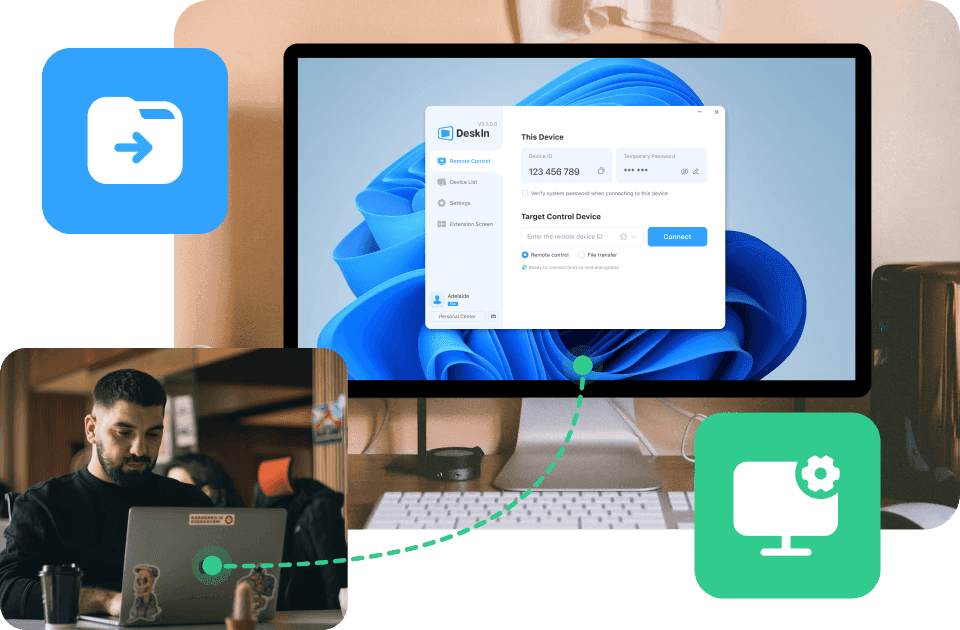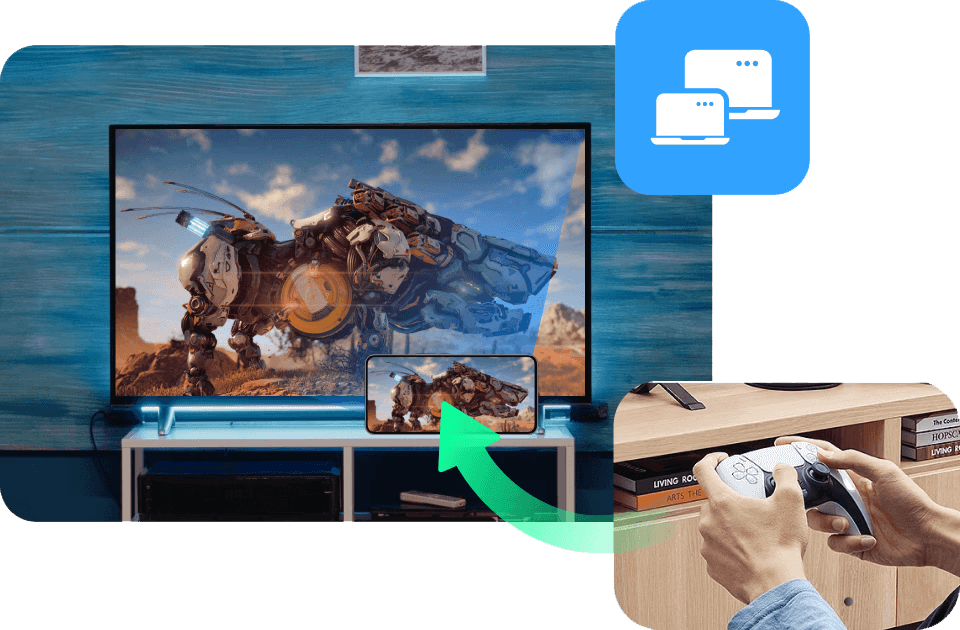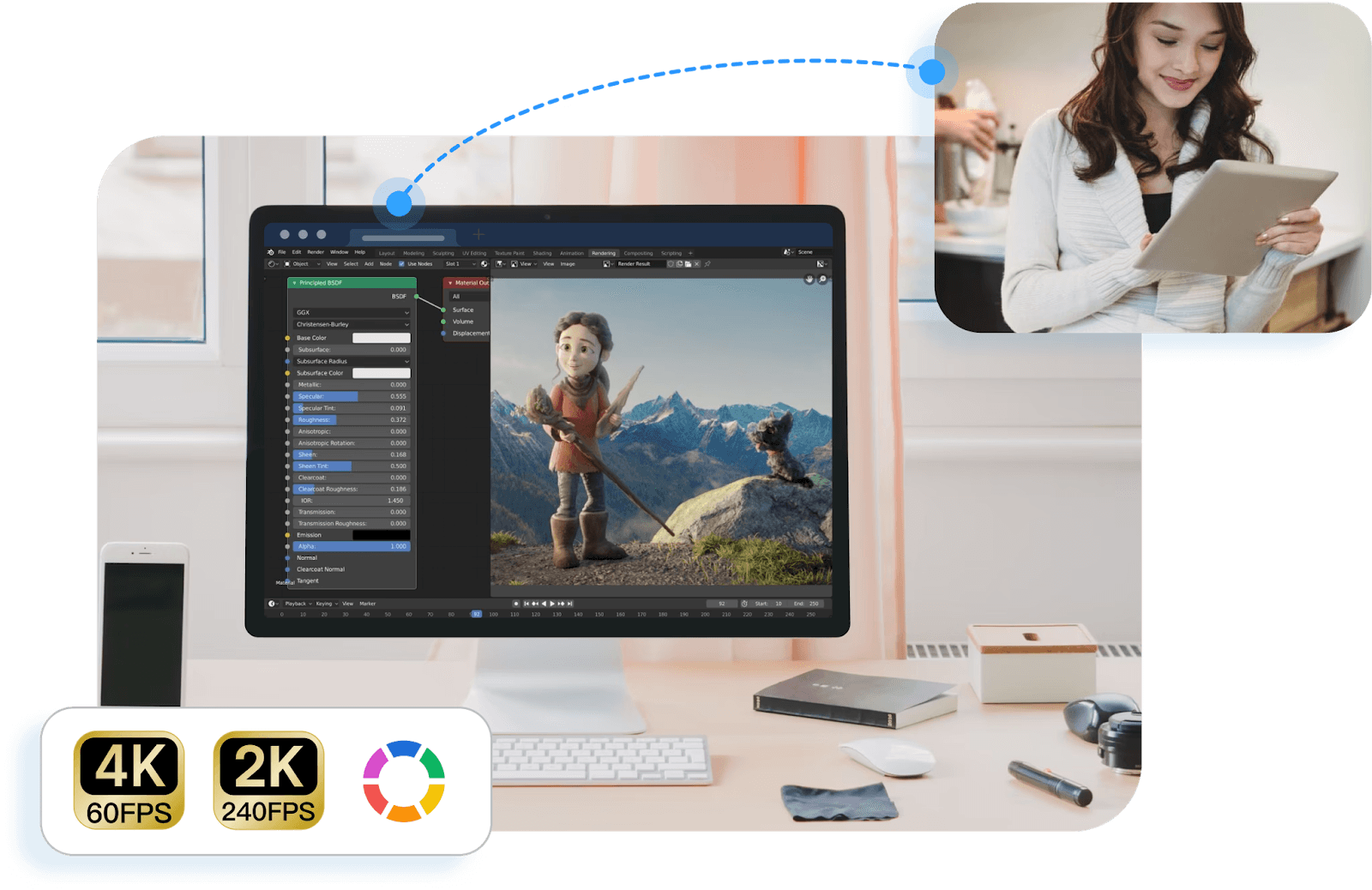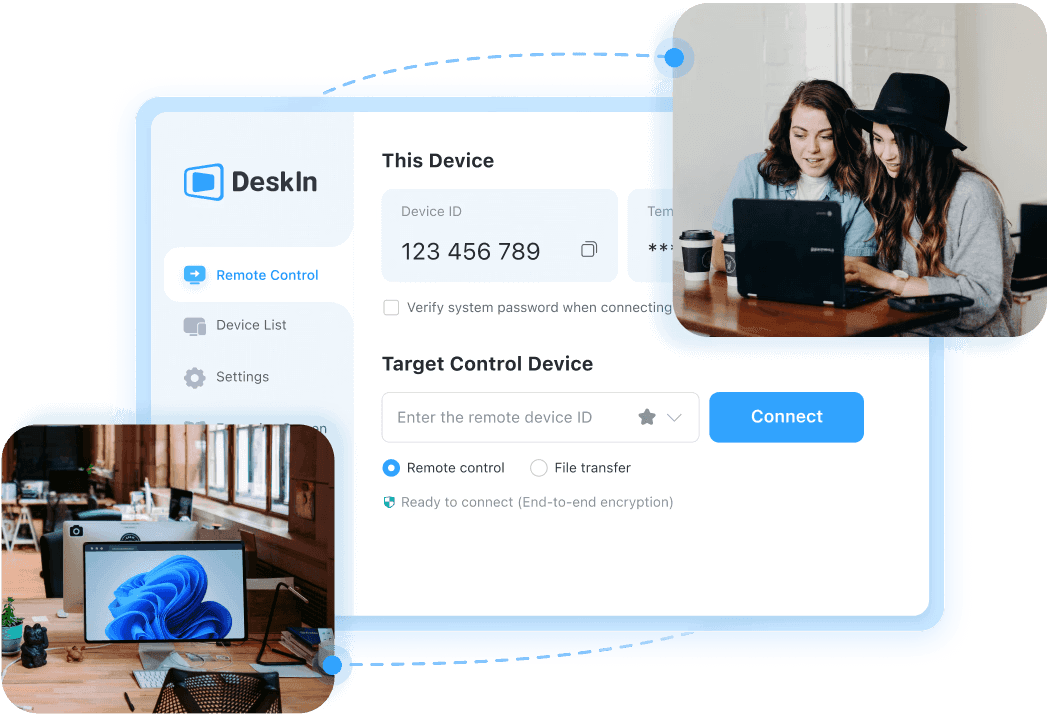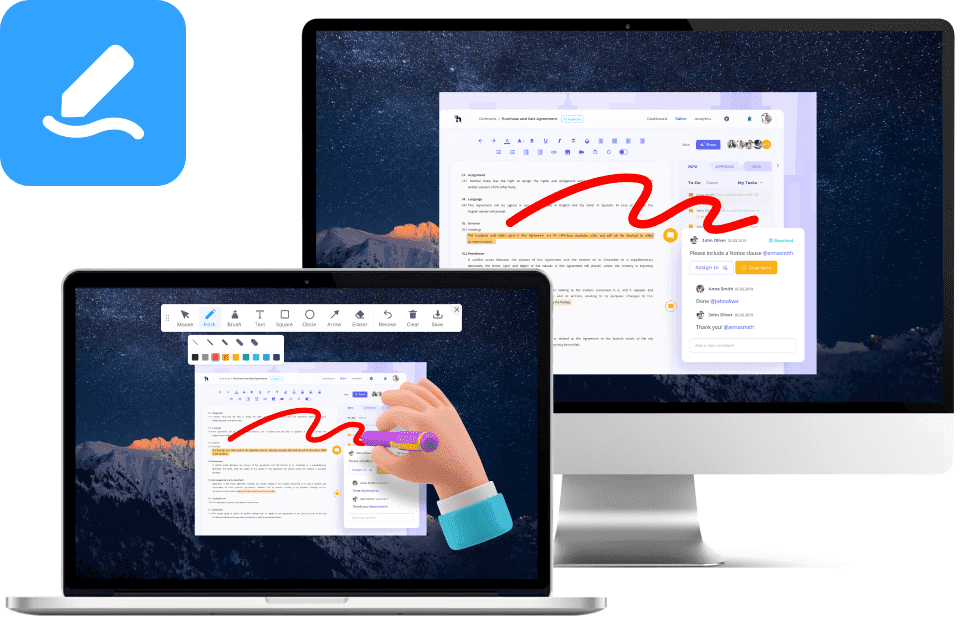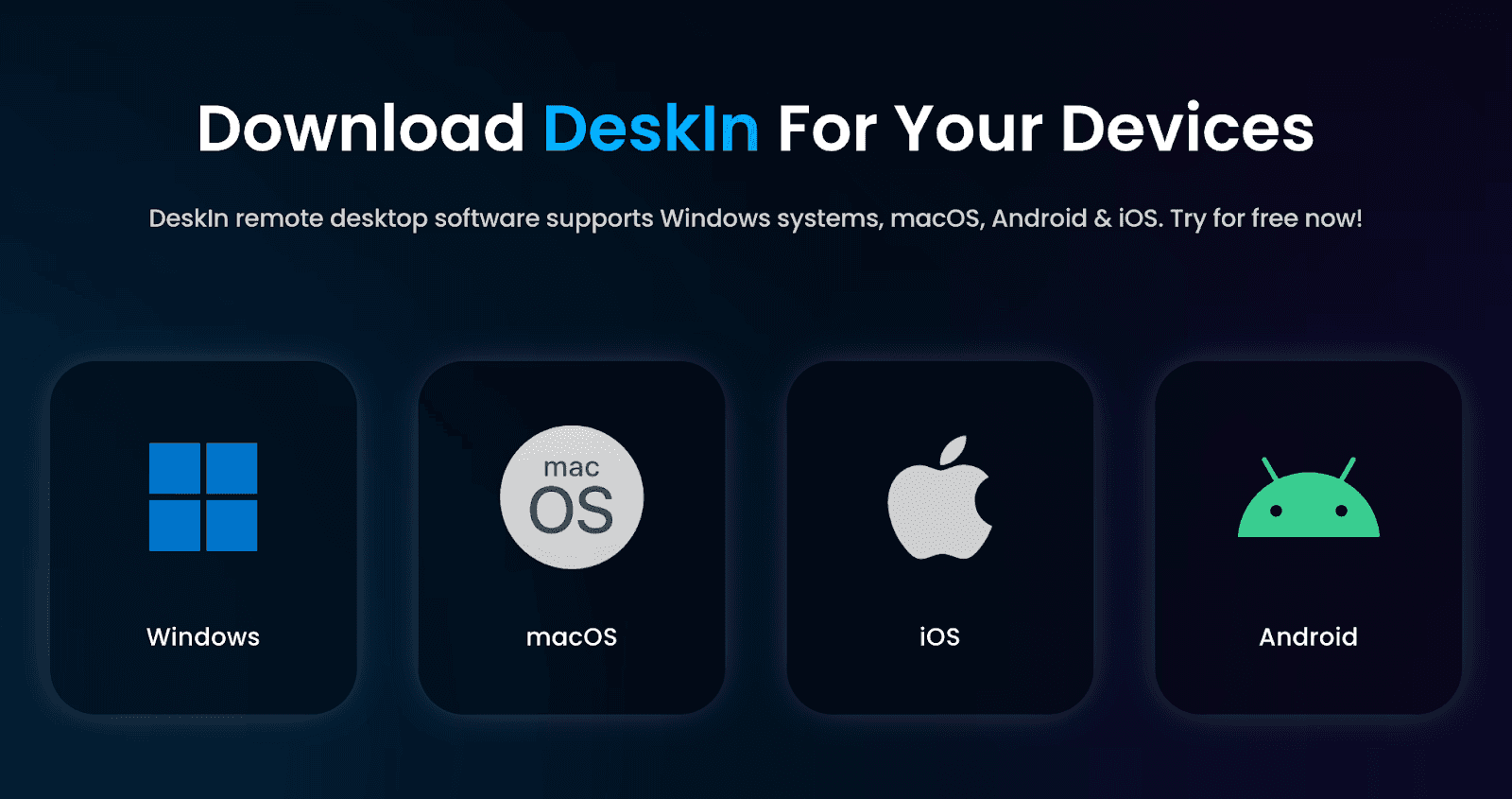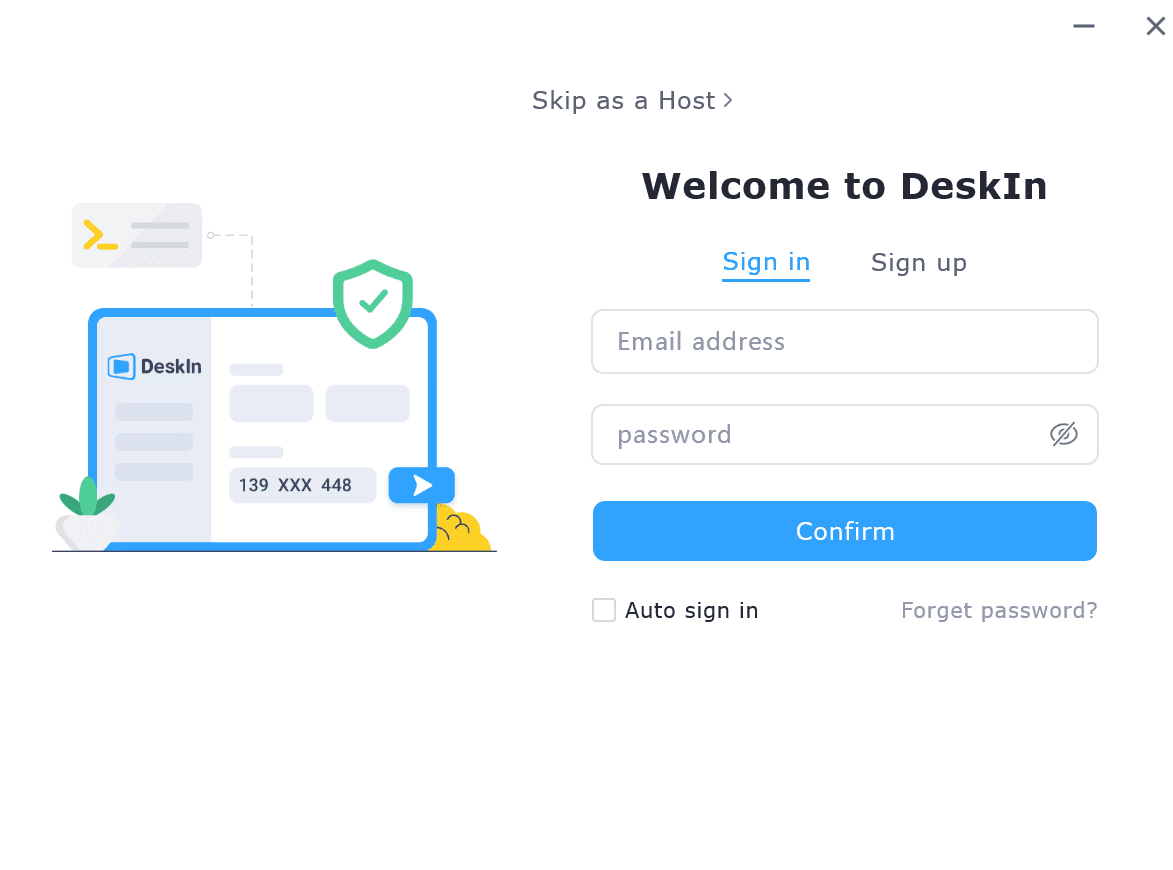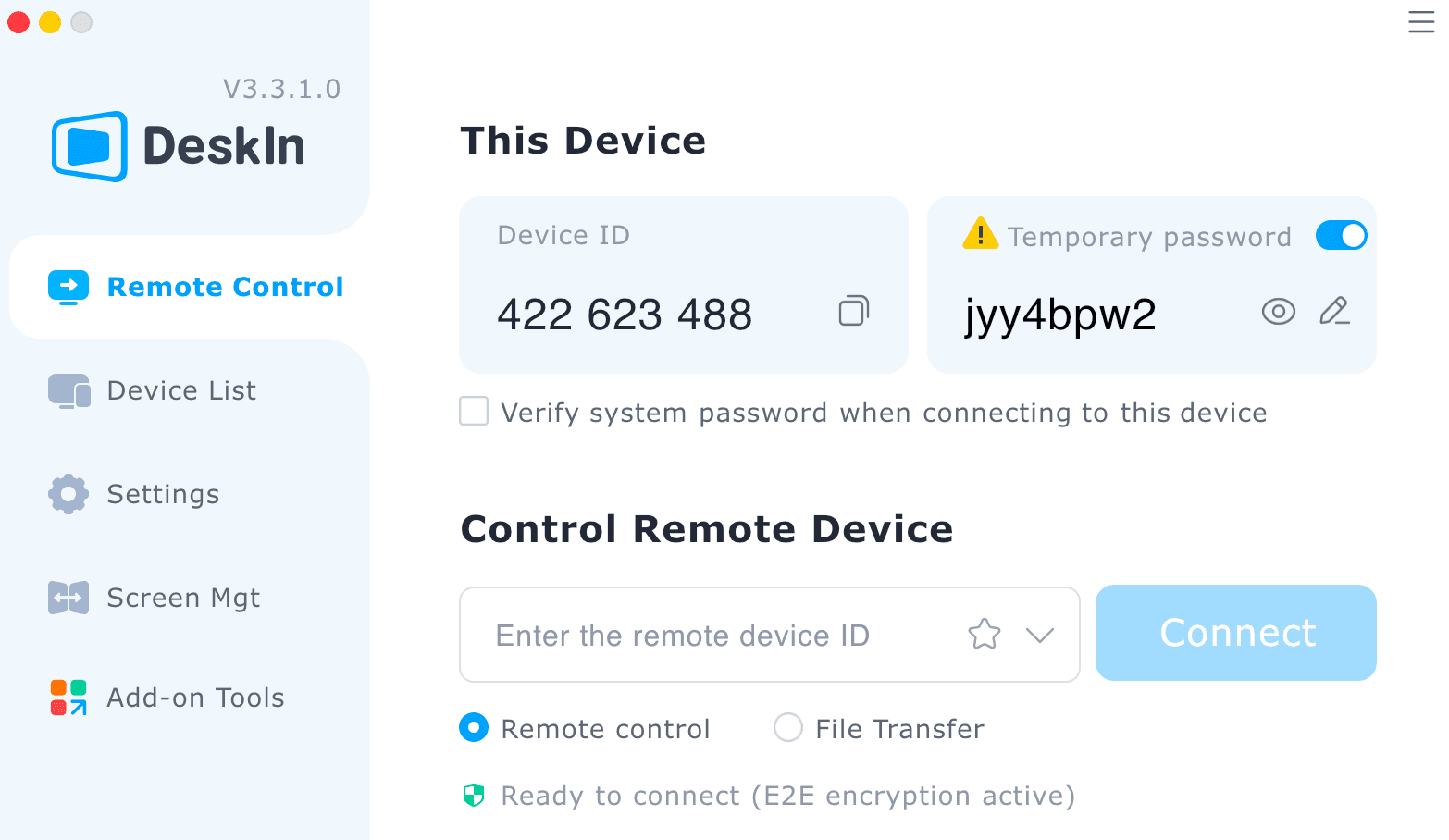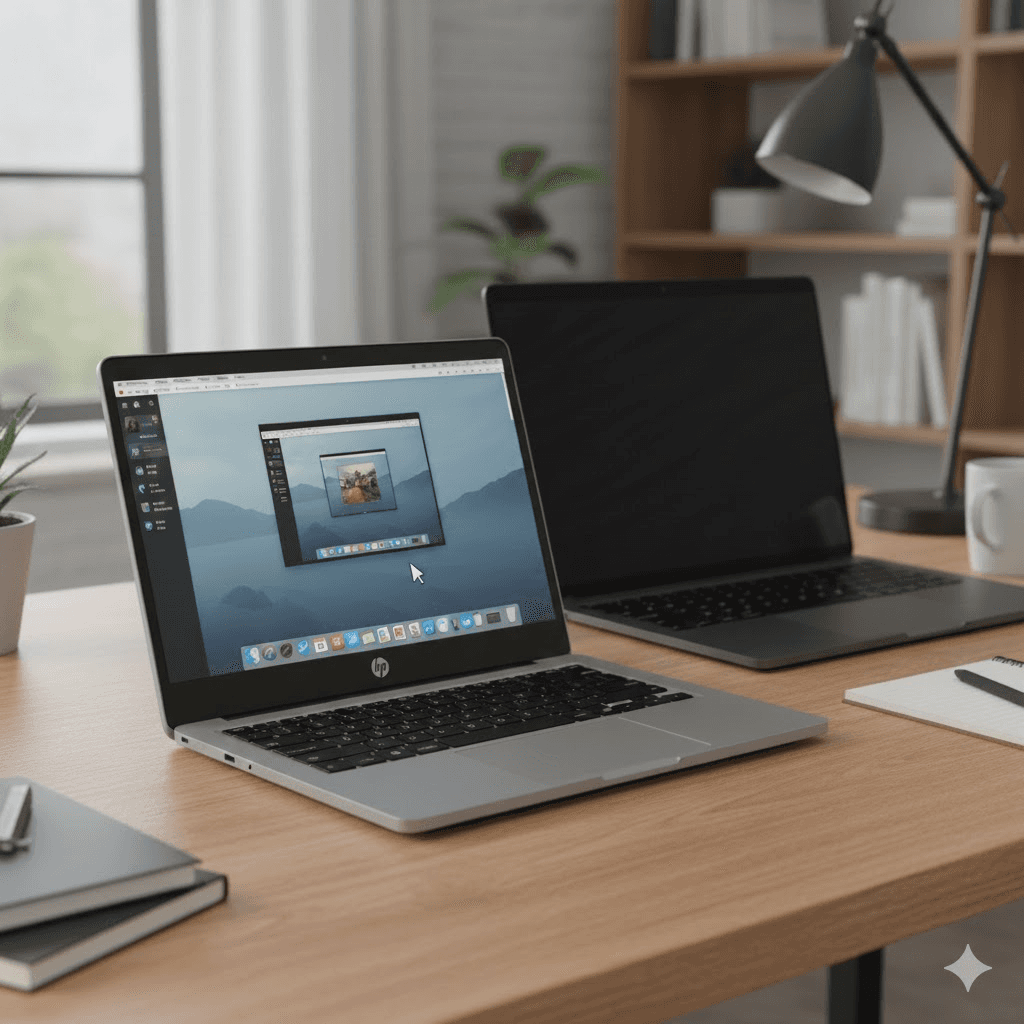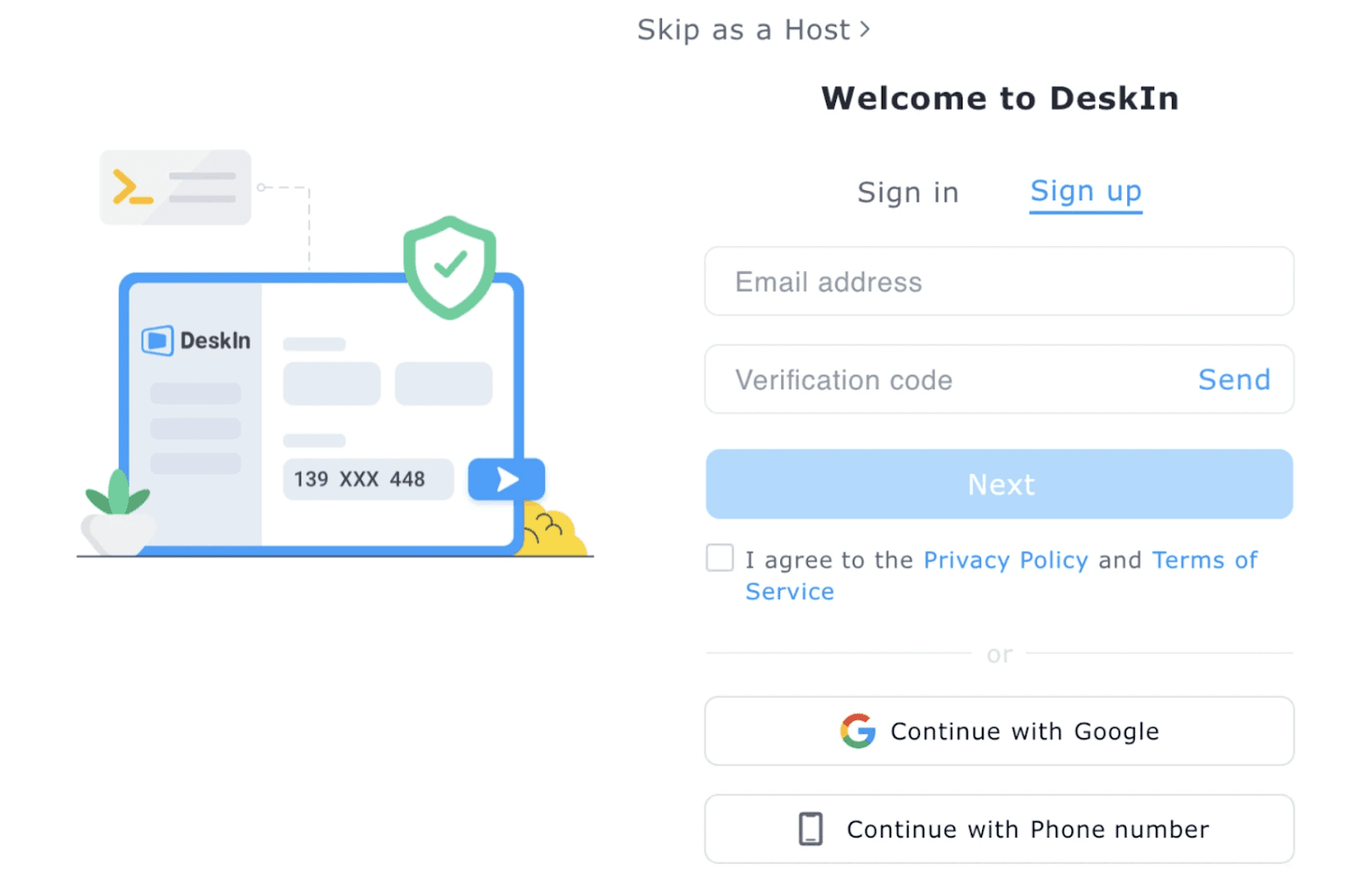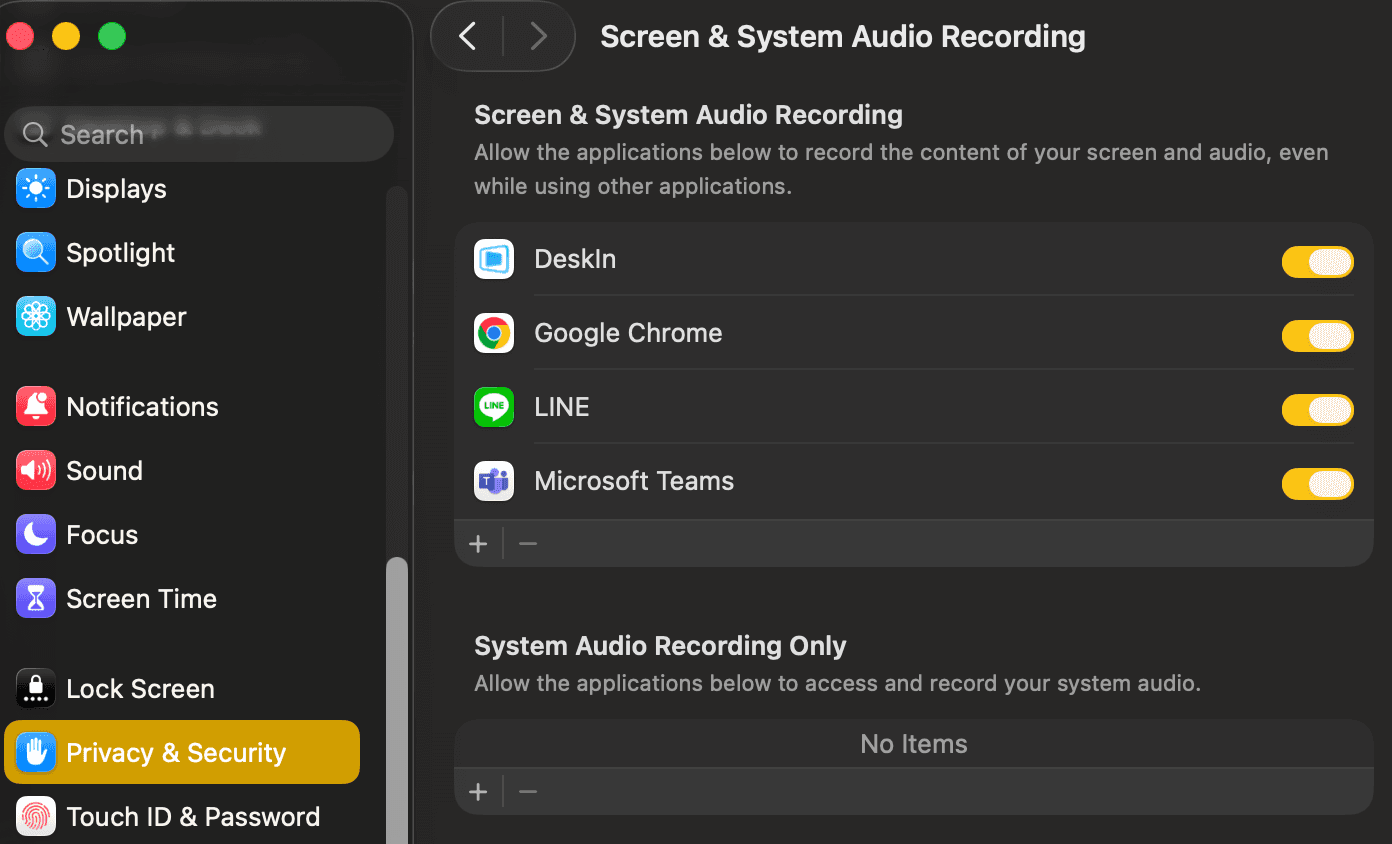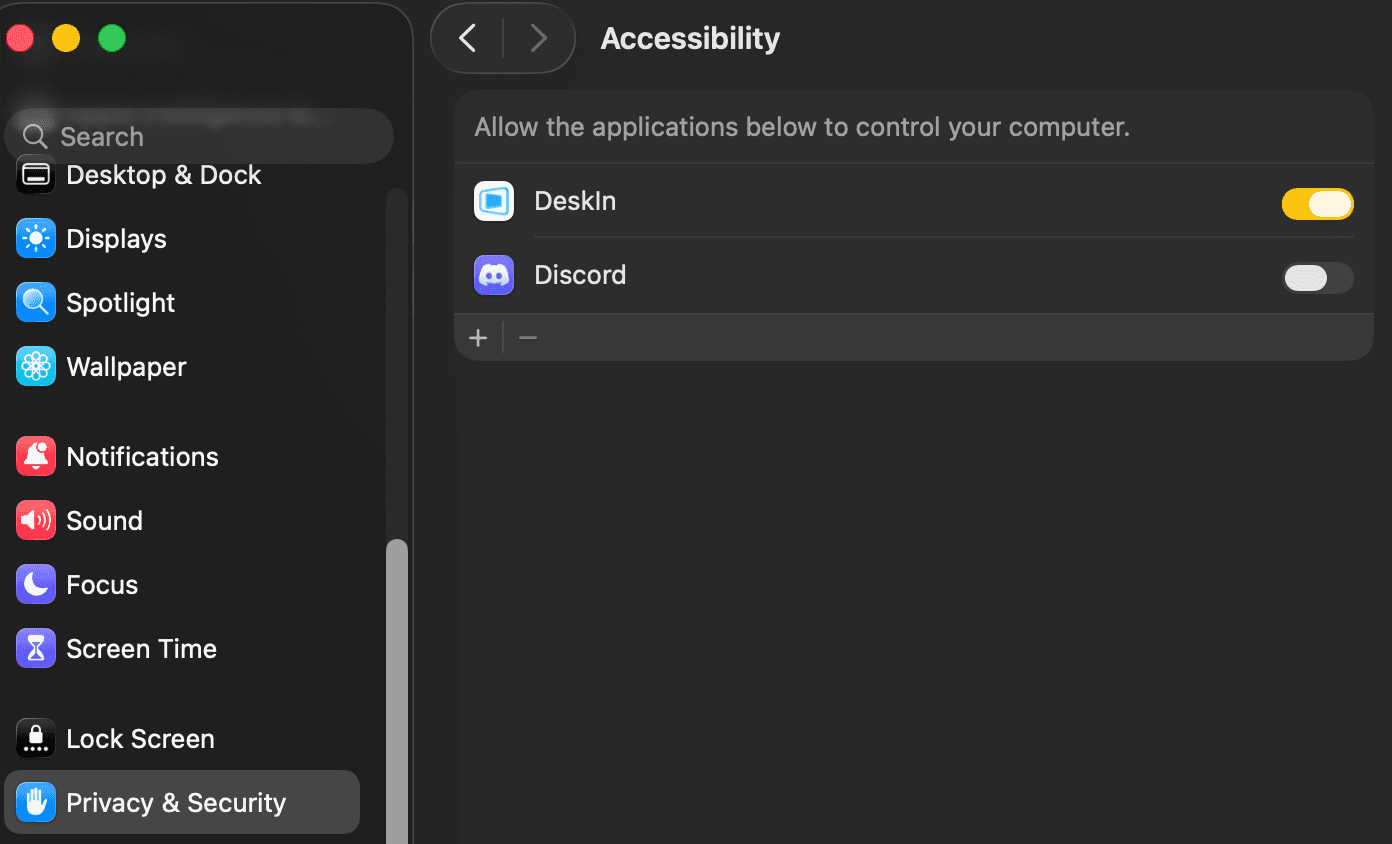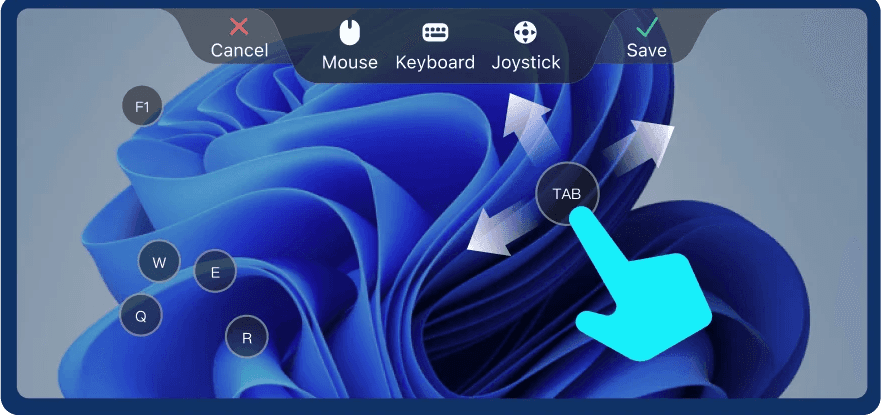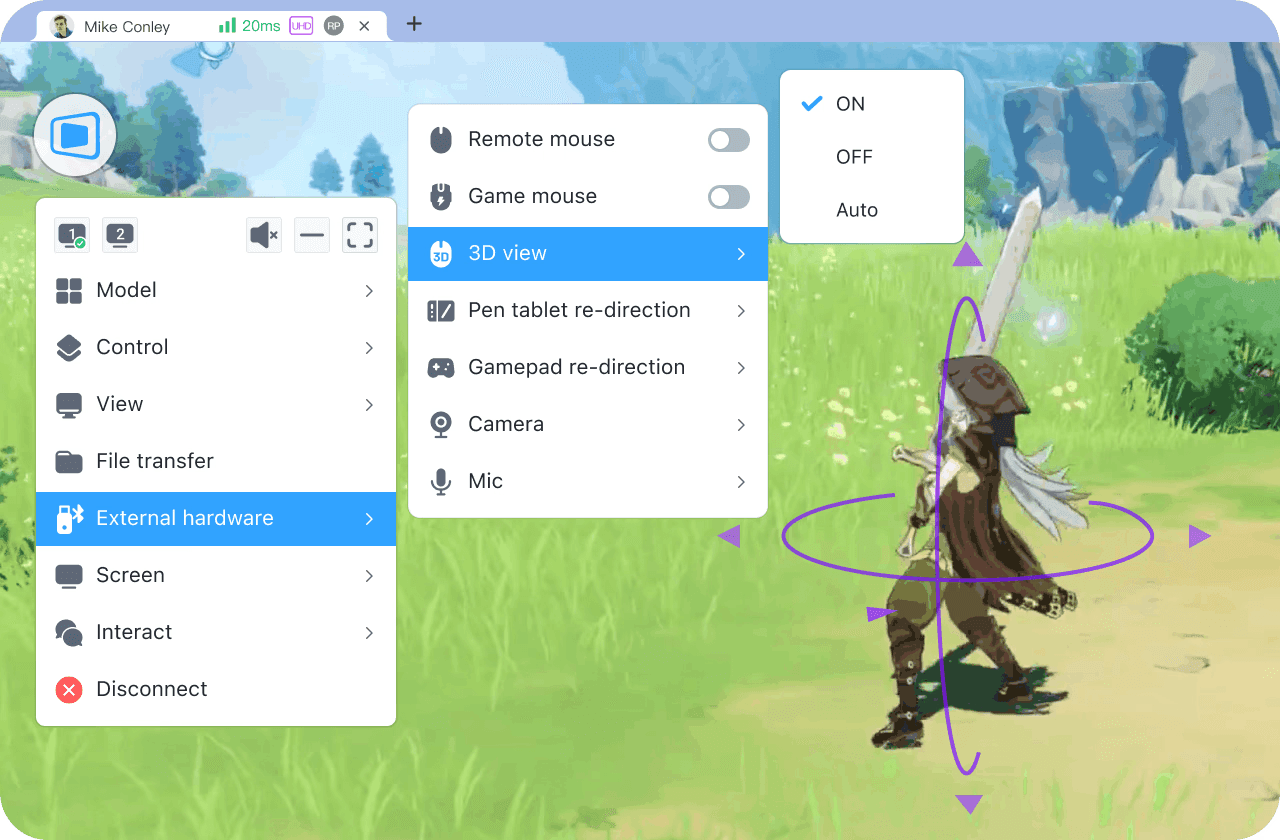Connecting Android to PC goes beyond just photo transfers — it's a smart way to boost productivity, streamline file access, and even control your devices remotely. Whether you're working from home, studying, or gaming, a solid Android-to-PC connection can make everyday tasks faster and easier.
In this guide, we'll show you the easiest ways to connect your phone to a PC, using USB, Microsoft Phone Link, Bluetooth file transfer, or using DeskIn, a powerful tool to help you get Android connected to PC remotely or nearby. Let's get started!
👀 Related Reading:
Part 1. Connect Android to PCs Remotely (2 Quick Ways)
For users who need remote file transfers or screen sharing, here are two simple methods to remotely connect your PC. Follow these methods to enhance productivity and access your devices right away!
Way 1. Use Best Remote Desktop Software - DeskIn
People need to control an Android device from pc, share files between the devices, or cast the android to Windows, the fastest way is using a third-party solution like DeskIn. It is a powerful, cross-platform app that enables wirelessly remote control PC, file transfer, and screen sharing between Android phones and PCs. Whether you're working remotely, gaming, or simply trying to move files without limits, DeskIn provides a smooth and secure connection, even on weak networks like hotspots or public Wi-Fi.


📌 How DeskIn Helps Android PC Remote Connection
Remote Control: Fully control your Android device or PC from another device, with support for touch gestures, keyboard input, and game controllers.
File Transfer: Transfer large files at speeds up to 12MB/s, with no restrictions on file type or size.
Cross-Platform Access: Connect across all major systems — Android, iOS, Windows, and macOS — and even use your tablet or phone as a second screen.
Privacy Protection: Includes privacy screen mode, device access management (blacklist/whitelist), and email verification for added security.
Extra Tools: Features like virtual screens, remote camera access, multi-screen expansion, and real-time screen mirroring make it ideal for power users, creators, and travelers.
All these sparkling features have made DeskIn the best remote software for Windows PC and mobile phones. Now, let's see how to connect mobile to laptop using DeskIn within easy-handling steps.
Step 1. Download and Install DeskIn
Go to the official DeskIn website on both your Android phone and your PC. Download the appropriate version for each device and complete the installation process.

Step 2. Create and Sign In to Your DeskIn Account
Open the DeskIn app on both devices and sign in using the same account. For new users, Deskin now offers free trial with no time limits. Just register with your email address.
Step 3. Link Devices and Choose Connection Mode
Once signed in, you'll see the device ID and the password of your Android device. Input them on your PC, and once the mobile phone and your laptop are successfully connected, you can then explore the features under Connection:
Remote Control – Fully control your PC or Android remotely from another device.
File Transfer – Send files like docoments and photos quickly between devices.
Screen Sharing – Mirror your screen - Android or PC - in real-time.

Step 4. Start the Connection
Click on the function you want to use, and follow the prompts to initiate the session. DeskIn will automatically establish a secure connection. Depending on your needs, you can enable extra features like virtual screen, privacy mode, or remote camera within the app settings.

For steps to transfer files, do check: How to Transfer Large Files from PC remotely?

Way 2. Use the Microsoft Phone Link App to Sync Data
If you want to connect your Android phone to a PC wirelessly, the Microsoft Phone Link app provides a native solution that's great for syncing messages, calls, and media, especially useful for people who frequently switch between devices.
Before you start, make sure your PC is updated to Windows 10 (October 2018 update or later) or Windows 11, your Android device is running Android 7.0 or newer, and both devices are connected to the same Wi-Fi network.
Step 1. On your Windows 10 or 11 PC, open or install the Phone Link app (preinstalled on most devices).
Step 2. On your Android phone, download the Link to Windows app from Google Play. Some phones (like Samsung Galaxy) may already have it built-in.
Step 3. Open both apps, then sign in with your Microsoft account or scan the QR code shown on your PC to pair the devices.
Step 4. Once paired, you can view and respond to texts, check notifications, view recent photos, and even make phone calls directly from your PC.

📌 Limits or Shortcomings:
It does not support full file explorer access (you can view recent photos, but not browse entire folders).
No support for remote control or screen mirroring, unless you're using select Samsung or Surface Duo devices with additional integration features.
Can't be used for large file transfers — for that, a great third-party app offers more flexibility. Please read on to explore.
Part 2. Connect Android Devices to Nearby PCs (2 Common Ways)
The most common ways to connect Android devices to a PC are still the traditional ones — using a USB cable or Microsoft's built-in Phone Link app. These methods are easy to set up and are ideal for transferring files, viewing notifications, or syncing basic data between devices.
Way 3. Using a USB Cable
Connecting your Android phone to a PC using a USB cable is one of the simplest and most reliable methods. It allows high-speed data transfer without needing an internet connection, and it works on virtually all Android and Windows devices.
Here's how to connect Android to PC via USB:
Step 1. Use a compatible USB cable (preferably the original one) to connect your Android phone to your PC.
Step 2. On your phone, a prompt will appear. Tap "Charging this device via USB", then choose "File Transfer" (MTP) from the list of USB options.
Step 3. On your PC, open "File Explorer". Your Android device will appear under "Devices and Drives."
Step 4. Click on the device to browse internal storage or SD card, then drag and drop files between devices.
Fail to transfer large files with USB?
Using USB cable is slow and prones to failure. Why not try Deskin? The remote access software offers fast and reliable file transfers. It is perfect for transferring sensitive documents and photos. Try it now with a FREE trial!


Fixes: Why is my phone not connecting to PC through USB?
If your Android phone isn't connecting to your PC, this may be your your computer not detecting android phone.
Ensure Your USB cable is working. Or try a different USB cable and port.
Check if the USB mode on your phone is set to "File Transfer" (MTP), and try restarting both devices.
If you're using a wireless connection, ensure both devices are on the same Wi-Fi network.
📌 Tips & Common Issues:
Connection not showing? Swipe down your notification panel and manually select the USB mode.
Can't connect to pc? Try a different USB port or cable, especially if using a third-party charger.
Drivers not installed? Windows may need to install Android USB drivers automatically. If not, check the manufacturer's website.
Way 4. Using Bluetooth for Sending Small Files
If you want to connect your mobile phone to laptop to transfer files between the two devices at work, Bluetooth is an excellent option. Bluetooth file transfer supports documents (PDF, Word, PPT), audio, photos, and short videos. Generally, it can transfer files at speeds of 1-3 MB/s.
It requires no cables and is easy to connect. Here's how to connect android phone to pc via Bluetooth.
Step 1. Turn on Bluetooth on Both Android and Windows
Turn on Bluetooth on your Android. Then, go to Setting > Add Bluetooth or other devices. Toggle on the Bluetooth on Windows.

Step 2. Pair Android Phone to PC via Bluetooth
Click Add Device > Bluetooth on PC. Confirm that the pairing code on your computer matches the one on your phone. If it does, click Connect on both devices.

Step 3. Transfer Files between Android & PC via Bluetooth
To transfer files to your Android over Bluetooth, right-click the Bluetooth icon, then choose Send a File or Receive a File. Select your Android from the list of available Bluetooth devices.
Browse for the file you want to transfer to your Android, you can transfer music, photos, documents between the Android and computer. Then choose Open > Next. Windows should transfer the files to your Android.

[Fixes]: Android can't connect to pc bluetooth? Try the fixes below!
Error 1: Why am I not able to transfer files from phone to laptop via Bluetooth?
Make sure the device that files will be sent from appears and shows as Paired.
Keep the window open and confirm you want to receive a file via Bluetooth whenever you want to send a file to the PC.
The process isn't as automatic and fast as remote desktop apps. If you need a better solution to solve this issue, consider DeskIn, the best remote desktop software. Use its free version to transfer files immediately!


✍️ Related Reading: How to Send Sensitive Documents & Files via Email
Quick Comparison: 4 Ways for Android to PC Connection
Now that you've learned about DeskIn and its powerful features, let's take a moment to compare it with other traditional methods of connecting Android to PC. Below is a detailed table that outlines the pros and cons of each connection method, helping you make an informed choice based on your needs and preferences.
Method | Speed | Ease of Use | Security | File Limits | Extra Features |
|---|---|---|---|---|---|
DeskIn | High (up to 12MB/s) | Very High (easy setup, no cables) | High (email verification, privacy mode) | None (unlimited size) | Remote control, 2nd screen, virtual screen, remote camera, cross-platform support, etc. |
Microsoft Phone Link | Medium (dependent on Wi-Fi) | High (easy setup with Microsoft account) | High (Microsoft account security) | Yes (limited file types) | Call, SMS, media sync, notifications on PC |
USB Cable | High (up to 5 Gbps) | Moderate (requires cable) | High (no internet required) | None (direct access) | Direct file access, reliable for large transfers |
Bluetooth | Slow | Moderate | High | Yes (limited file types) | No extra features |
FAQs About Connecting Android Phone to PC/Computer
How to connect android phone to PC without USB cable?
Here are two ways to share files. One is using Bluetooth. Bluetooth file transfer is common and can transfer files, music, and documents. However, it's relatively slow and unsuitable for large files.
Therefore, Method 2 is more recommended: using remote desktop access software. This type of software provides fast file transfer capabilities, easily handles large files, and also offers remote screen sharing, making collaboration much easier and more efficient. Choose remote access tools for better performance and flexibility.

Can I use my Android phone as a second screen for my PC?
Yes, with DeskIn, you can easily use your Android phone as a second screen for your PC. This can help boost productivity by providing extra screen space for multitasking.
How can I transfer large files from Android to PC?
If you're transferring large files, DeskIn offers a fast and secure way to move files at speeds up to 12MB/s without file size restrictions. However, using a USB cable or Microsoft Phone Link may be slower and have file size limits. DeskIn supports drag-and-drop transfers for large files, including folders, videos, and documents, all at high speed without size or format restrictions.
Conclusion
There are several methods available to connect your Android phone to your PC, each catering to different needs. While USB cables and Microsoft Phone Link are great for basic tasks like file transfers and syncing messages, they have their limitations in terms of flexibility and advanced functionality.
For a seamless, all-in-one solution that offers full control, fast transfers, and cross-device productivity, DeskIn stands out as the best option. Whether you're working remotely, gaming, or managing files, DeskIn provides a smooth and powerful experience across all devices. Give it a try, unlock its range of features, and connect Android to PC to boost your work and play right away!

Connecting Android to PC goes beyond just photo transfers — it's a smart way to boost productivity, streamline file access, and even control your devices remotely. Whether you're working from home, studying, or gaming, a solid Android-to-PC connection can make everyday tasks faster and easier.
In this guide, we'll show you the easiest ways to connect your phone to a PC, using USB, Microsoft Phone Link, Bluetooth file transfer, or using DeskIn, a powerful tool to help you get Android connected to PC remotely or nearby. Let's get started!
👀 Related Reading:
Part 1. Connect Android to PCs Remotely (2 Quick Ways)
For users who need remote file transfers or screen sharing, here are two simple methods to remotely connect your PC. Follow these methods to enhance productivity and access your devices right away!
Way 1. Use Best Remote Desktop Software - DeskIn
People need to control an Android device from pc, share files between the devices, or cast the android to Windows, the fastest way is using a third-party solution like DeskIn. It is a powerful, cross-platform app that enables wirelessly remote control PC, file transfer, and screen sharing between Android phones and PCs. Whether you're working remotely, gaming, or simply trying to move files without limits, DeskIn provides a smooth and secure connection, even on weak networks like hotspots or public Wi-Fi.


📌 How DeskIn Helps Android PC Remote Connection
Remote Control: Fully control your Android device or PC from another device, with support for touch gestures, keyboard input, and game controllers.
File Transfer: Transfer large files at speeds up to 12MB/s, with no restrictions on file type or size.
Cross-Platform Access: Connect across all major systems — Android, iOS, Windows, and macOS — and even use your tablet or phone as a second screen.
Privacy Protection: Includes privacy screen mode, device access management (blacklist/whitelist), and email verification for added security.
Extra Tools: Features like virtual screens, remote camera access, multi-screen expansion, and real-time screen mirroring make it ideal for power users, creators, and travelers.
All these sparkling features have made DeskIn the best remote software for Windows PC and mobile phones. Now, let's see how to connect mobile to laptop using DeskIn within easy-handling steps.
Step 1. Download and Install DeskIn
Go to the official DeskIn website on both your Android phone and your PC. Download the appropriate version for each device and complete the installation process.

Step 2. Create and Sign In to Your DeskIn Account
Open the DeskIn app on both devices and sign in using the same account. For new users, Deskin now offers free trial with no time limits. Just register with your email address.
Step 3. Link Devices and Choose Connection Mode
Once signed in, you'll see the device ID and the password of your Android device. Input them on your PC, and once the mobile phone and your laptop are successfully connected, you can then explore the features under Connection:
Remote Control – Fully control your PC or Android remotely from another device.
File Transfer – Send files like docoments and photos quickly between devices.
Screen Sharing – Mirror your screen - Android or PC - in real-time.

Step 4. Start the Connection
Click on the function you want to use, and follow the prompts to initiate the session. DeskIn will automatically establish a secure connection. Depending on your needs, you can enable extra features like virtual screen, privacy mode, or remote camera within the app settings.

For steps to transfer files, do check: How to Transfer Large Files from PC remotely?

Way 2. Use the Microsoft Phone Link App to Sync Data
If you want to connect your Android phone to a PC wirelessly, the Microsoft Phone Link app provides a native solution that's great for syncing messages, calls, and media, especially useful for people who frequently switch between devices.
Before you start, make sure your PC is updated to Windows 10 (October 2018 update or later) or Windows 11, your Android device is running Android 7.0 or newer, and both devices are connected to the same Wi-Fi network.
Step 1. On your Windows 10 or 11 PC, open or install the Phone Link app (preinstalled on most devices).
Step 2. On your Android phone, download the Link to Windows app from Google Play. Some phones (like Samsung Galaxy) may already have it built-in.
Step 3. Open both apps, then sign in with your Microsoft account or scan the QR code shown on your PC to pair the devices.
Step 4. Once paired, you can view and respond to texts, check notifications, view recent photos, and even make phone calls directly from your PC.

📌 Limits or Shortcomings:
It does not support full file explorer access (you can view recent photos, but not browse entire folders).
No support for remote control or screen mirroring, unless you're using select Samsung or Surface Duo devices with additional integration features.
Can't be used for large file transfers — for that, a great third-party app offers more flexibility. Please read on to explore.
Part 2. Connect Android Devices to Nearby PCs (2 Common Ways)
The most common ways to connect Android devices to a PC are still the traditional ones — using a USB cable or Microsoft's built-in Phone Link app. These methods are easy to set up and are ideal for transferring files, viewing notifications, or syncing basic data between devices.
Way 3. Using a USB Cable
Connecting your Android phone to a PC using a USB cable is one of the simplest and most reliable methods. It allows high-speed data transfer without needing an internet connection, and it works on virtually all Android and Windows devices.
Here's how to connect Android to PC via USB:
Step 1. Use a compatible USB cable (preferably the original one) to connect your Android phone to your PC.
Step 2. On your phone, a prompt will appear. Tap "Charging this device via USB", then choose "File Transfer" (MTP) from the list of USB options.
Step 3. On your PC, open "File Explorer". Your Android device will appear under "Devices and Drives."
Step 4. Click on the device to browse internal storage or SD card, then drag and drop files between devices.
Fail to transfer large files with USB?
Using USB cable is slow and prones to failure. Why not try Deskin? The remote access software offers fast and reliable file transfers. It is perfect for transferring sensitive documents and photos. Try it now with a FREE trial!


Fixes: Why is my phone not connecting to PC through USB?
If your Android phone isn't connecting to your PC, this may be your your computer not detecting android phone.
Ensure Your USB cable is working. Or try a different USB cable and port.
Check if the USB mode on your phone is set to "File Transfer" (MTP), and try restarting both devices.
If you're using a wireless connection, ensure both devices are on the same Wi-Fi network.
📌 Tips & Common Issues:
Connection not showing? Swipe down your notification panel and manually select the USB mode.
Can't connect to pc? Try a different USB port or cable, especially if using a third-party charger.
Drivers not installed? Windows may need to install Android USB drivers automatically. If not, check the manufacturer's website.
Way 4. Using Bluetooth for Sending Small Files
If you want to connect your mobile phone to laptop to transfer files between the two devices at work, Bluetooth is an excellent option. Bluetooth file transfer supports documents (PDF, Word, PPT), audio, photos, and short videos. Generally, it can transfer files at speeds of 1-3 MB/s.
It requires no cables and is easy to connect. Here's how to connect android phone to pc via Bluetooth.
Step 1. Turn on Bluetooth on Both Android and Windows
Turn on Bluetooth on your Android. Then, go to Setting > Add Bluetooth or other devices. Toggle on the Bluetooth on Windows.

Step 2. Pair Android Phone to PC via Bluetooth
Click Add Device > Bluetooth on PC. Confirm that the pairing code on your computer matches the one on your phone. If it does, click Connect on both devices.

Step 3. Transfer Files between Android & PC via Bluetooth
To transfer files to your Android over Bluetooth, right-click the Bluetooth icon, then choose Send a File or Receive a File. Select your Android from the list of available Bluetooth devices.
Browse for the file you want to transfer to your Android, you can transfer music, photos, documents between the Android and computer. Then choose Open > Next. Windows should transfer the files to your Android.

[Fixes]: Android can't connect to pc bluetooth? Try the fixes below!
Error 1: Why am I not able to transfer files from phone to laptop via Bluetooth?
Make sure the device that files will be sent from appears and shows as Paired.
Keep the window open and confirm you want to receive a file via Bluetooth whenever you want to send a file to the PC.
The process isn't as automatic and fast as remote desktop apps. If you need a better solution to solve this issue, consider DeskIn, the best remote desktop software. Use its free version to transfer files immediately!


✍️ Related Reading: How to Send Sensitive Documents & Files via Email
Quick Comparison: 4 Ways for Android to PC Connection
Now that you've learned about DeskIn and its powerful features, let's take a moment to compare it with other traditional methods of connecting Android to PC. Below is a detailed table that outlines the pros and cons of each connection method, helping you make an informed choice based on your needs and preferences.
Method | Speed | Ease of Use | Security | File Limits | Extra Features |
|---|---|---|---|---|---|
DeskIn | High (up to 12MB/s) | Very High (easy setup, no cables) | High (email verification, privacy mode) | None (unlimited size) | Remote control, 2nd screen, virtual screen, remote camera, cross-platform support, etc. |
Microsoft Phone Link | Medium (dependent on Wi-Fi) | High (easy setup with Microsoft account) | High (Microsoft account security) | Yes (limited file types) | Call, SMS, media sync, notifications on PC |
USB Cable | High (up to 5 Gbps) | Moderate (requires cable) | High (no internet required) | None (direct access) | Direct file access, reliable for large transfers |
Bluetooth | Slow | Moderate | High | Yes (limited file types) | No extra features |
FAQs About Connecting Android Phone to PC/Computer
How to connect android phone to PC without USB cable?
Here are two ways to share files. One is using Bluetooth. Bluetooth file transfer is common and can transfer files, music, and documents. However, it's relatively slow and unsuitable for large files.
Therefore, Method 2 is more recommended: using remote desktop access software. This type of software provides fast file transfer capabilities, easily handles large files, and also offers remote screen sharing, making collaboration much easier and more efficient. Choose remote access tools for better performance and flexibility.

Can I use my Android phone as a second screen for my PC?
Yes, with DeskIn, you can easily use your Android phone as a second screen for your PC. This can help boost productivity by providing extra screen space for multitasking.
How can I transfer large files from Android to PC?
If you're transferring large files, DeskIn offers a fast and secure way to move files at speeds up to 12MB/s without file size restrictions. However, using a USB cable or Microsoft Phone Link may be slower and have file size limits. DeskIn supports drag-and-drop transfers for large files, including folders, videos, and documents, all at high speed without size or format restrictions.
Conclusion
There are several methods available to connect your Android phone to your PC, each catering to different needs. While USB cables and Microsoft Phone Link are great for basic tasks like file transfers and syncing messages, they have their limitations in terms of flexibility and advanced functionality.
For a seamless, all-in-one solution that offers full control, fast transfers, and cross-device productivity, DeskIn stands out as the best option. Whether you're working remotely, gaming, or managing files, DeskIn provides a smooth and powerful experience across all devices. Give it a try, unlock its range of features, and connect Android to PC to boost your work and play right away!


Play x Work
All at Once
DeskIn Remote Game
only $14.32 USD 🎉 Limited on July 16-31
Add promo code: deskinsummer1






